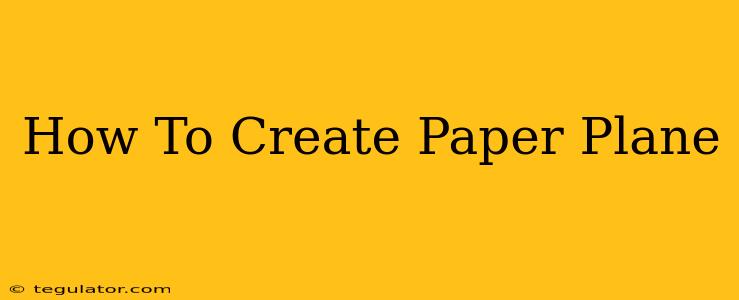Want to soar to new heights of paper airplane mastery? This comprehensive guide will walk you through creating a classic paper airplane design, perfect for indoor fun or outdoor flights. We'll cover everything from choosing the right paper to perfecting the folds for maximum distance and flight time. Get ready for takeoff!
Choosing Your Paper: The Foundation of Flight
The paper you choose significantly impacts your paper airplane's performance. Avoid flimsy papers that will tear easily, and steer clear of overly thick cardstock that will be too heavy to fly. Here's what to look for:
- Lightweight: Standard printer paper (8.5 x 11 inches) is ideal. It's readily available and provides a good balance of weight and durability.
- Smooth Surface: A smooth surface reduces air resistance, leading to a longer and more stable flight.
- No Wrinkles: Ensure your paper is flat and wrinkle-free for optimal aerodynamic performance. Ironing it lightly can help if needed.
The Classic Dart Design: A Step-by-Step Tutorial
This classic dart design is known for its excellent range and stability. Follow these instructions carefully for optimal results:
Step 1: Prepare Your Paper
Lay your paper flat with the long edge facing you.
Step 2: Fold in Half
Fold the paper in half lengthwise, crease sharply, and unfold. This creates a center line, your guide for the next steps.
Step 3: Fold the Top Corners
Fold both top corners down to the center crease you just made. Make sure the edges align perfectly with the center.
Step 4: Fold the Top Flaps Down
Fold the top flaps down again, this time folding them in half.
Step 5: Fold the Airplane in Half
Fold the entire airplane in half along the original center crease, bringing the top folded edges together.
Step 6: Adjust the Wings
This is crucial! Gently bend the wings outward to create the airplane's wings. Experiment with different angles to find what works best for your paper and throwing style. A slight upward bend at the wingtips can increase lift.
Tips for Achieving Maximum Flight
- Throwing Technique: A smooth, overhand throw is key. Use a gentle, consistent motion, releasing the airplane with a flick of the wrist. Avoid throwing too hard, as this can lead to instability.
- Wing Adjustments: Fine-tune the wing angles after each throw. Slight adjustments can make a huge difference in flight performance.
- Air Current: Throw your airplane into the wind for longer flights.
- Practice Makes Perfect: The more you practice, the better you’ll become at throwing and fine-tuning your airplane for optimal distance and flight time.
Beyond the Basics: Exploring Other Designs
Once you've mastered the classic dart design, explore other paper airplane designs! There's a whole world of possibilities, from simple variations to complex models capable of impressive feats of flight. Searching online will reveal countless tutorials and plans.
Conclusion: Take Flight with Your Paper Airplane!
Creating and flying paper airplanes is a fun and rewarding activity for all ages. By following these simple steps and experimenting with different techniques, you can create paper airplanes that will fly further and longer than you ever thought possible. So grab some paper, and let the adventure begin!

